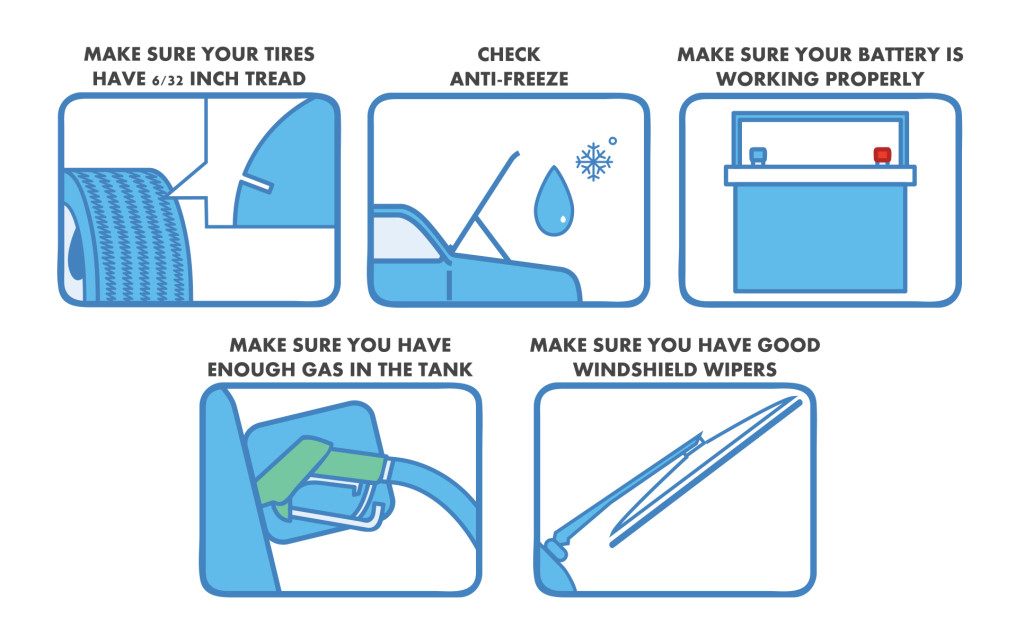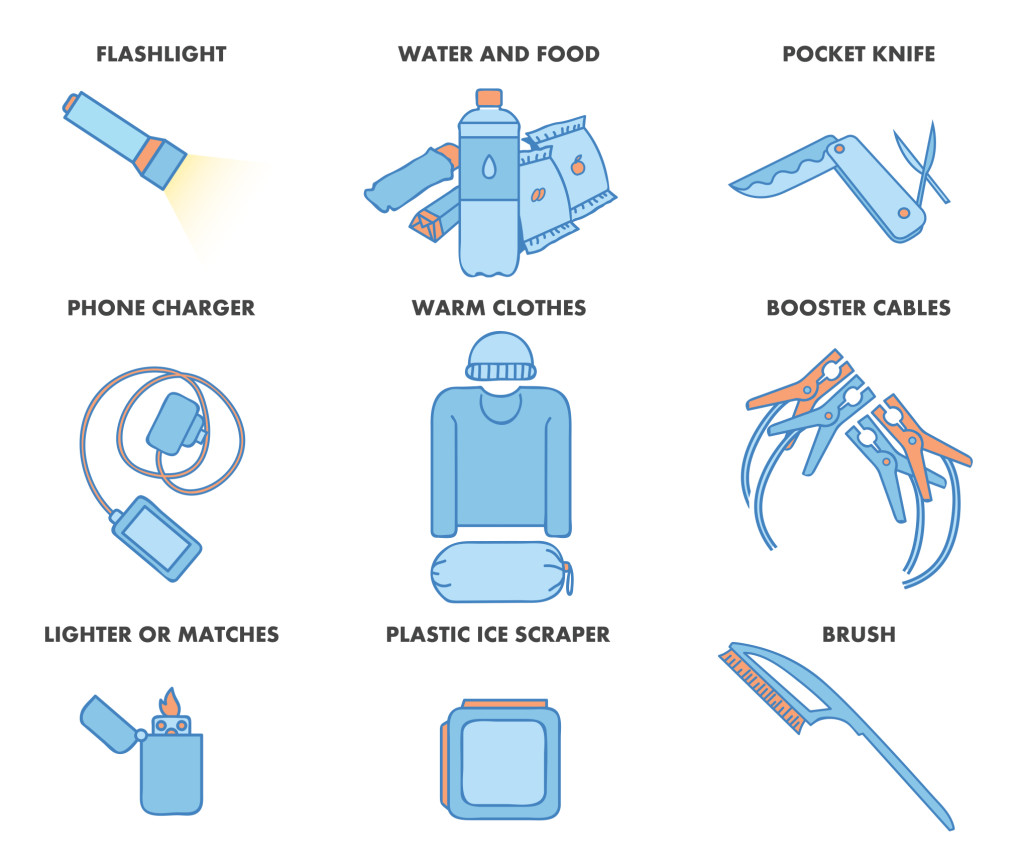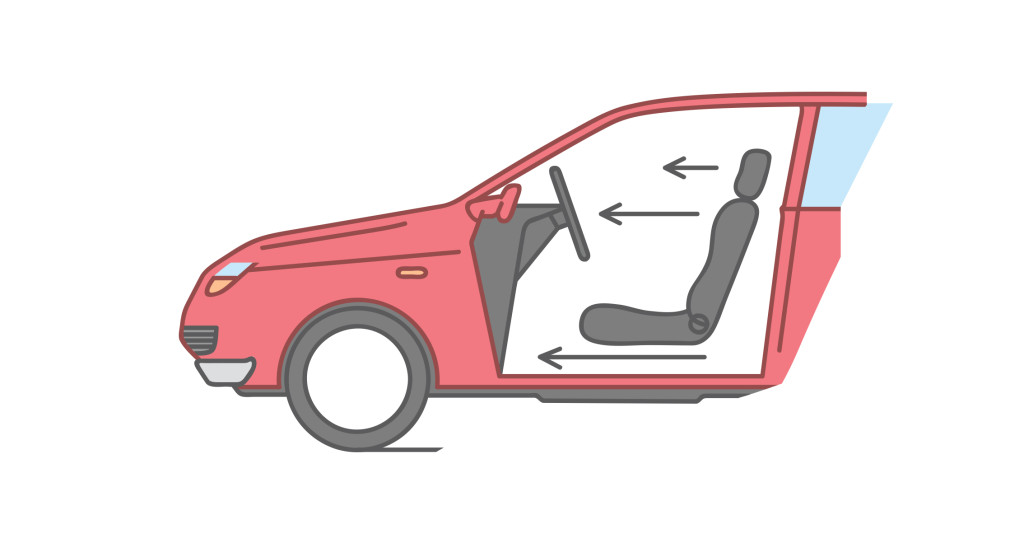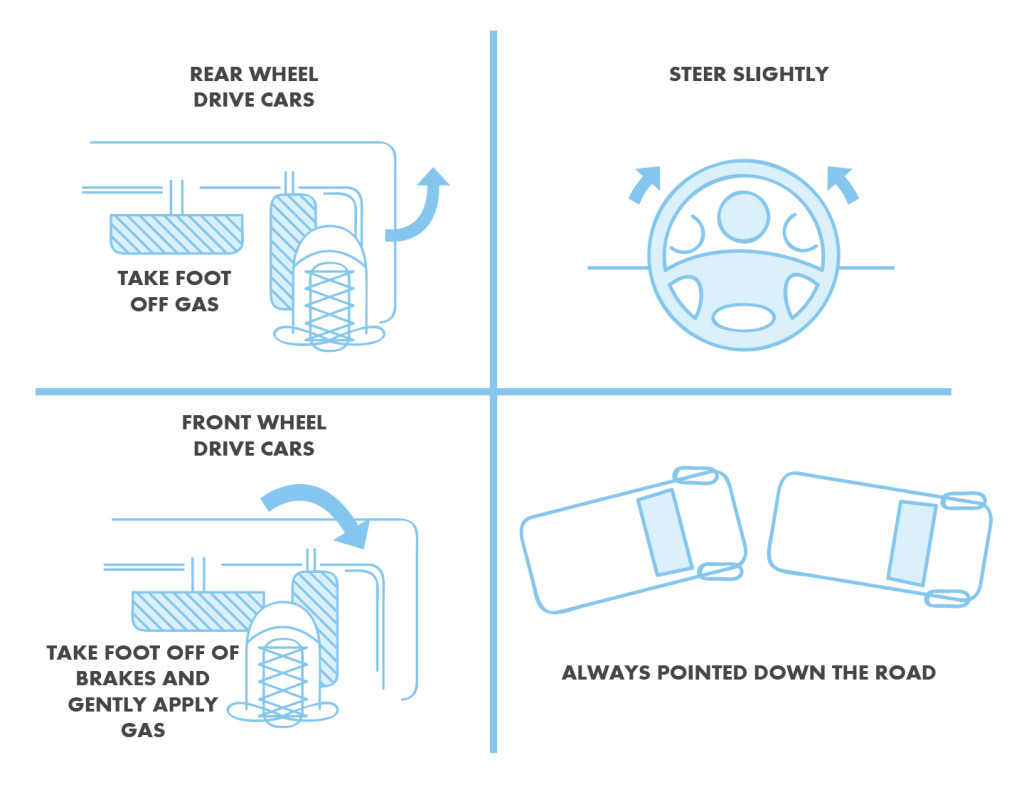An Illustrated Guide to Driving Safely in the Snow
Driving Safely on Icy or Snowy Roads
If you live in a part of the country with even occasional severe winter weather, you need to know how to drive safely on icy or snowy roads. This guide is designed to help you prepare for driving in winter weather, get your car ready to go when it’s time to venture out, have a safe trip, and survive if things go wrong.
Before the first snowflake falls or the temperature drops to below freezing, it is time to think about preparing to drive in winter weather. After all, as Benjamin Franklin said, “By failing to prepare, you are preparing to fail.”
So what needs to be done to be really prepared for winter driving? The answer is three-fold: prepare the car, prepare a survival kit, and prepare yourself.
Preparing the car

First of all, your car needs care all year, every year. However, winter requires special care. The list of things that should be done to “winterize” your car is long, but don’t worry. Your car care professional knows the list, or if you are a do-it-yourselfer, simply read your car’s manual for the proper maintenance procedures.
- Some things are obvious: don’t forget antifreeze and the right oil grade for the weather.
- Tires are always on your defensive line; your tread should have at least 6/32 inch depth. Snow tires are great for long hard winters, but they should be removed when the temperature reaches 45 degrees on a regular basis. Don’t bother with them if your area has only occasional snow and ice.
- Less obvious things need attention too: Have you got good windshield wipers and is the washer fluid reservoir full? Is the battery charging properly?
- Is there plenty of gas in the tank? The last thing you want in winter weather is to run out of gas on the side of the road!
Preparing a survival kit
Today’s cars have amazing features to prevent accidents. Unfortunately, sometimes nothing will stop a car from sliding into a ditch in the snow. Now is the time you will wish you had prepared a winter survival kit. Prepare it as soon as winter raises its cold, hoary head and check it before you set off on your winter driving to make sure everything is there.
- Things to stay alive: A few bottles of water are always valuable, but also put in some things to eat. Raisins and other dried fruit are good because they won’t go bad in your kit and they pack lots of energy. A few mini-candy bars left over from Halloween will be helpful. Also consider other snack items like protein bars or crackers. A good first aid kit can be bought at many stores and added to the emergency box. A pocket knife is also a multi-use item that might come in handy. A couple of days’ worth of essential medications are a good idea, but be sure to replace these every few weeks. Medications often deteriorate away from their original bottles or in the changing temperatures of your car.
- Things to keep warm: First, you need extra gloves, socks, and hats. This may seem silly because you will have these things on before you get on your car. Yes, but when these are crusted with snow or wet, you will be glad to have extra in your kit. That’s also why you might also want an extra pair of shoes in your kit too. After all, if you have to walk away from your car in the snow, you don’t want to be wearing the dressy shoes you wore to the office. A sleeping bag or blanket is essential. And a candle and matches are a good idea not only for light but for those few degrees of heat the candle will generate.
- Things to let people know where you are: A cell phone charger in the survival kit is less likely to accidentally get removed from the car. A flashlight will help you signal others and to assess your situation. A distress flag can be purchased at an auto supply store, but a brightly colored scarf or bandana will also help people find your car in a snowdrift when it is tied to the car antenna. Get emergency flares (and read the instructions for use in advance!) from auto supply stores too. Consider taking a child’s whistle to attract potential rescuers. It will take up very little room in your emergency box.
- Things to move snow: Most lists for a survival kit tell you to carry a shovel. You can get one with a folding handle, but you can also get by with a heavy-duty dustpan. You want something you can use to scoop snow out of the way of your exhaust pipe or away from your wheels. You also want a whisk broom or a child’s broom to clear away snow from the windows. And invest in a plastic ice scraper for the windshield. In the spring, you can look around in parking lots and see windshields with scratches; those belong to people who tried using other things to scrape ice.
- Things to move the car: Booster cables are an excellent thing to keep in the car any time. A common problem in snow and ice is lack of traction for the wheels. A mix of sand and salt is optimal, but plain cat litter will provide some traction. Even strips of old carpet get you traction in the snow. And in case you find someone willing to help you get your car out of the snow, a tow chain or rope is helpful.
Now that you have your kit, it will seem natural to put them in the trunk of your car. A better place is your back seat. Trunks have an annoying habit of freezing shut or becoming jammed in an accident. You want your survival kit where you can get to it.
Preparing yourself
During World War II, there were signs in train stations asking “Is this trip REALLY necessary?” Imagine that sign on the front of your car all winter. Remember that even if you know how to drive in snow and ice, there will probably be plenty of people on the road who do not.
- Even if you have to travel, consider if you have to travel Are you tired or sleepy? These are contraindicated with driving at any time but they could become deadly conditions in bad weather. You need to be as alert as possible to drive in snow and ice.
- Once you have decided you really have to go, plan your route. Perhaps you usually go via back roads, but maybe it would be better to go via the more widely travelled roads under icy conditions. They are more likely to be cleared. If you have several errands, you also want to plan a route that limits the amount of time you are on the road. Once you have a plan, share it. Be sure someone knows where you are going and how long you plan to be gone. It may be important to know your route if a search has to be initiated.
- Be sure your cell phone is charged and with you. Bad weather may interfere with reception but if you become stranded, the weather may clear. If you run into trouble, be sure the GPS function of your phone is turned on. Some people keep it turned off to save battery life, but when it is turned on, it can help rescuers find you.
Getting the Car Ready to Go
Now your car has been winterized. The survival kit is in the back seat. You have decided you have to go and you have planned your route. It is time to actually leave the house. But there is only a large snow drift where your car used to be. Unfortunately, that is your car. You need to dig it out before you can leave. This may make you re-think how badly you need to go anywhere. No matter how fluffy snow looks when it comes down, it is heavy when you are trying to move it. According to the American Heart Association, winter is the season of heart attacks, often associated with shoveling snow.
- First, clear the exhaust pipe area so the car can be started without the chance of carbon monoxide backing up into the interior. Then start the car and turn on the front and rear defrosters. This will almost immediately start to weaken the hold the ice or snow has on your windshield. Leave the car running while you clear the snow from the rest of the car. This is not a waste of gasoline. You are using the gasoline to improve the visibility, and thus the safety, of your car. What could be a better use of fuel?
- Ensure that the seat is properly positioned so that you aren’t stretching to reach the gas pedal or steering wheel.
- The first place to clear is the space in front of your car so that air can flow into the engine compartment. A blocked radiator will cause the engine to overheat. Yes, a car can overheat in a sub-zero environment.
- There is a temptation to use hot water to clear the windshields. Don’t give in to that temptation. Hot water is very likely to shatter the windshield. Cold water is acceptable, although it will probably freeze into a pool of ice around your car. That will not help you drive away. The best choice is a plastic ice scraper made for clearing the windshield.
- Following every snowstorm, you will see people peering out of their cars through small peepholes of cleared snow on their windshields. Many terms may be used to describe these drivers, but “stupid” and “reckless” cover the situation just fine. As the inside of the car and thus the windshield warm, the grip of the snow and ice on the glass gives way. At any moment, the “peephole” of vision could be destroyed by the snow sliding down the glass. Always clear the entire windshield. And don’t count on the windshield wipers to do all the work. They were meant only to squeegee away water. The heavy lifting of removing large amounts of snow will damage them.
- The outside mirrors and lights were each placed on the car for a reason. Would you seriously consider driving the car without them? Then why would you think of driving your car without clearing them of snow and ice? Likewise, the back window should be cleared so you can see behind you. And if you do not have the rear window cleared, the inside rearview mirror is worthless.
- Now consider the roof of your car. It might be tempting to ignore the roof because snow there does not interfere with your vision. However, it is illegal in some areas not to clear it off. Why? Imagine a mattress flying off the top of the car in front of you and landing on your hood. That would certainly disturb your concentration on the road, wouldn’t it? The fact that this mattress-sized mass is made of snow or ice won’t change that. And remember, if you value your paint, use a brush or a broom to clear snow. A shovel might be quicker, but it will easily scratch the car’s body.
- If you have become sweaty while clearing your car, be sure to change into warm, layered clothes before leaving on your trip. Wet clothing next to your skin will be uncomfortable in the warm car. And if you have to walk anywhere, the wet clothing will not provide insulation.
- When you have cleared the car of snow, give your tires a head start on moving by clearing the area in front of all four tires. Tires hit the least resistance when they are moving in a straight line. The sharper the front tires are turned, the more resistance they face. This does not mean you can never make turns in the snow but it does mean that you should avoid acute turns when possible.
The Trip Itself
So now that you are pulling out of your driveway at last, let’s review some driving techniques. The good news is that you don’t have to remember these only for winter driving. Almost all of these are appropriate for round-the-year driving.
- Allow plenty of room between you and the cars around you. Snow or ice means it will be safer to add another car length or two between you and the car in front of you. Bear in mind that some careless driver may take this space as an invitation to get between you and the car in front of you. Do not react negatively to this. Just drop back a bit more from the interloper. After all, if the driver saw the empty space as a place to pull in, you don’t want to be too close when he makes his next wrong decision. In general, the larger the vehicle, the more space it will need to stop, so give big trucks, snow plows, and any vehicle with a trailer lots of extra room.
- Slow down. Most of us drive too fast on a frequent basis. Winter is a great time to change these ways. Remember that the slower you are going, the less likely you are to need to brake hard. Hard acceleration and braking are two excellent ways to start a skid.
- If you are driving, do not sightsee. Keep your eyes focused on where you want to go. Likewise, whether you are in a skid or not, steer the way you want to go. If you feel you are losing control, remain calm. Take care not to over-steer and keep your movements with either the brake or the accelerator light and steady.
If Things Go Badly
And what if, despite all your precautions, you end up in a snowbank? It could happen. Stay calm!
First, evaluate your situation.
- Are you going to be able to move the car back to the roadway?
- Do not spin the wheels. You will only dig in deeper. You want to dig out a little before you try driving. Remember not to overtire yourself. Clear the exhaust pipe and the front grill area.
- Now smooth a path near the tires. You need traction. This is why you brought the cat litter or sand or carpet scraps. Place your traction in front or behind the tires of the wheels that have power.
- Try to drive in the direction you’ve chosen with a steady pressure on the accelerator.
- Is the car there to stay for a while? Again, stay calm.
- If it is still snowing, stay with the car. It is extremely easy to become disoriented and lost. No storm in the history of the world has lasted forever. If you have notified someone of your plans, rescuers will be out when it is safe.
- Use your phone and attempt to reach 911 or your auto club for help. Be sure your GPS or location function is on to aid rescuers.
- Don’t worry. With your survival kit, you will be fine in your car for some time. Put on your extra clothing and use anything else in the car (floor mats, newspaper, or maps) as wraps to stay warm. Do not eat snow for hydration. Snow will overcool your core body temperature and may cause hypothermia.
- Be sure the exhaust area and the front grill area will allow circulation for the engine. Check this frequently as snow continues to fall or drift.
- Tie the brightly colored flag or scarf to something that can be seen from the road. Fasten it in a window or tie it to the antenna or even to a tree branch near the car.
- Run the car’s engine sparingly. At least one person in the car should stay awake to be sure that exhaust fumes do not build up in the car.
After the storm
Congratulate yourself on your success. Be sure to restock the survival kit as necessary. Maintain the car. Keep an eye on the weather. And stay home when you can.



